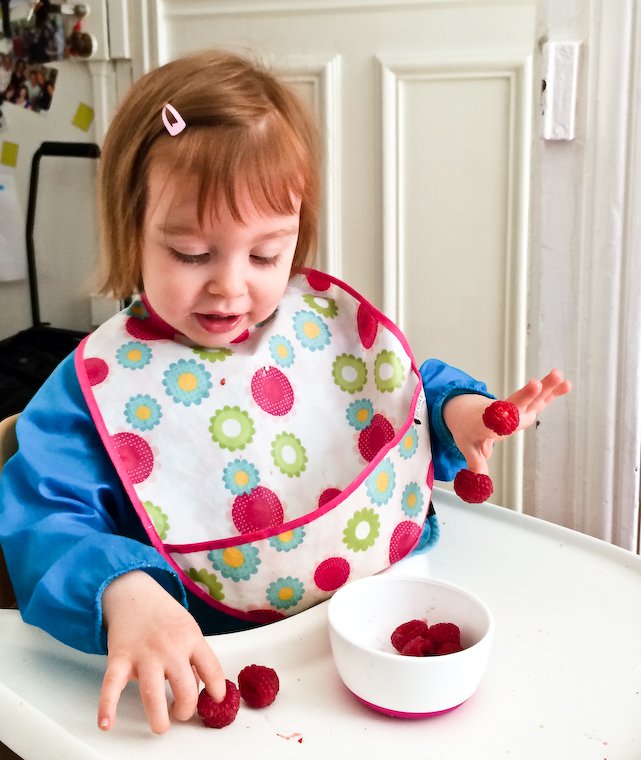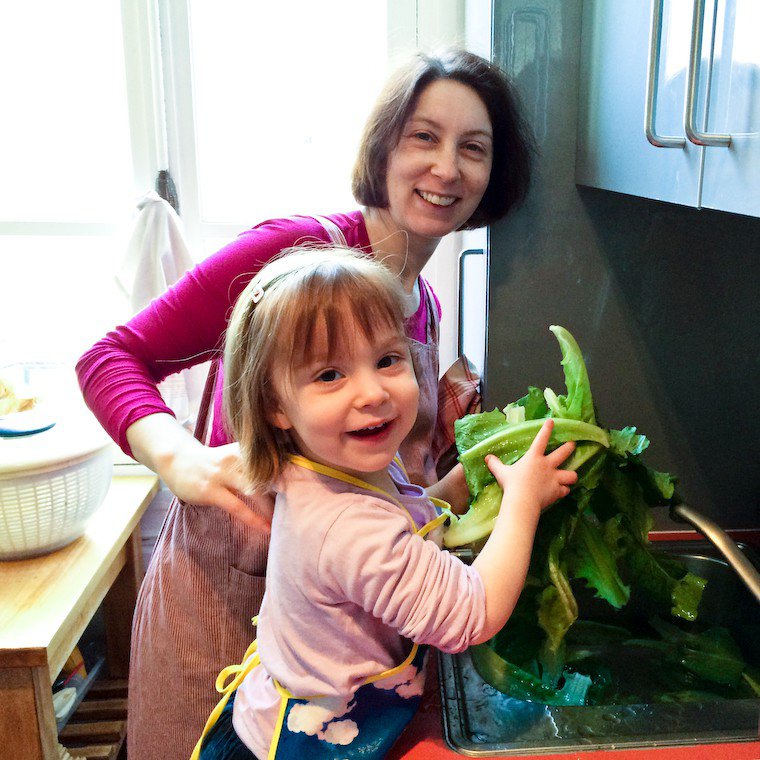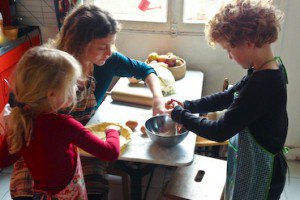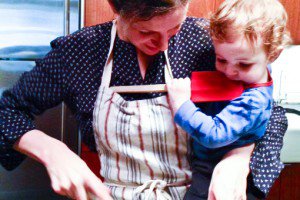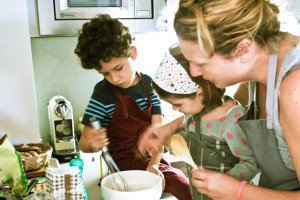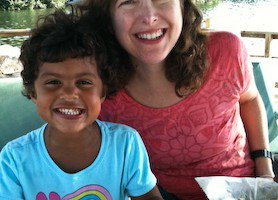Emily Mazo-Rizzi is an American who has been living in Paris since 1999, where she was initially working as an Internet project manager. She then went back to the United States for a year to train as a Pilates instructor, and has been teaching Pilates in Paris since 2010. She is married to a Frenchman, Bruno, and food and cooking have always been a central part of their life together.
I have known Emily for ten years, ever since she first got in touch as a reader of Chocolate & Zucchini, and over this decade she has become my very own Pilates teacher and a cherished friend. Her (adorable) daughter Olivia was born a few months after my own son Milan, so we have shared many a parenting conversation, and I have been so inspired by her way of involving Olivia in the kitchen that I knew I had to have her as a guest of my Parents Who Cook series. She was kind enough to accept my invitation, and I hope you enjoy reading about her approach. Thank you Emily!
Olivia is two and a half as I write. She is easygoing, observant, calm, curious, sweet, loves to move and loves to laugh. She adores cooking with us. She’s hesitant about trying new foods and shy about meeting new people, but ends up trying and warming up.
Did having a child change the way you cook?
Most definitely. In fact I think there is not a single aspect of my life that hasn’t changed since having a child! My husband Bruno and I used to spend well over an hour cooking dinner together each night. Our meals were not necessarily elaborate but we had two or three different things on our plates, or a starter and main course. Now we tend to have one-dish meals or one hot dish and one cold — usually some kind of a salad.
I am a Pilates instructor and work two evenings a week, so Bruno prepares meals on those evenings. The other nights I usually start preparing our meal while Olivia eats, then he takes over while I give her a bath. We haven’t gotten organized enough yet to eat early and together on weeknights, but that will be our goal for next fall.
Do you remember what it was like to cook with a newborn? Any tips or saving grace for new parents going through that phase?
Part of my nesting in preparing for Olivia’s arrival was making tomato sauce. She was born in October so we had good tomatoes from our farmer at the greenmarket until then. Bruno would laugh at me because we’d buy one or two kilos of tomatoes a week, and I’d cook them up into sauce and freeze them. It reassured me to know that when our baby was born we’d at least have homemade tomato sauce to put on pasta or make some sautéed veggies more interesting. We also made and froze a lot of chicken broth for risottos, soups, sauces. I think preparing your own food in advance is a great way to be ready for the baby’s birth.
Then when the baby arrived there was more take-out than we’ve ever had before or since. Bruno proudly donned his role as hunter-gatherer and headed out into cold, usually rainy, and then snowy Paris to come back with simple things to prepare. We love our greens so there were always vegetables. We also tried to make extra so there would be leftovers for the next day.
In the US, friends and family bring food to new parents. I wish that were the case in Paris! I think if I have another child I will be more forward and tell our friends coming to meet the baby: “Please don’t bring us any more baby presents; please bring us dinner!” A few American friends did and we were so grateful.
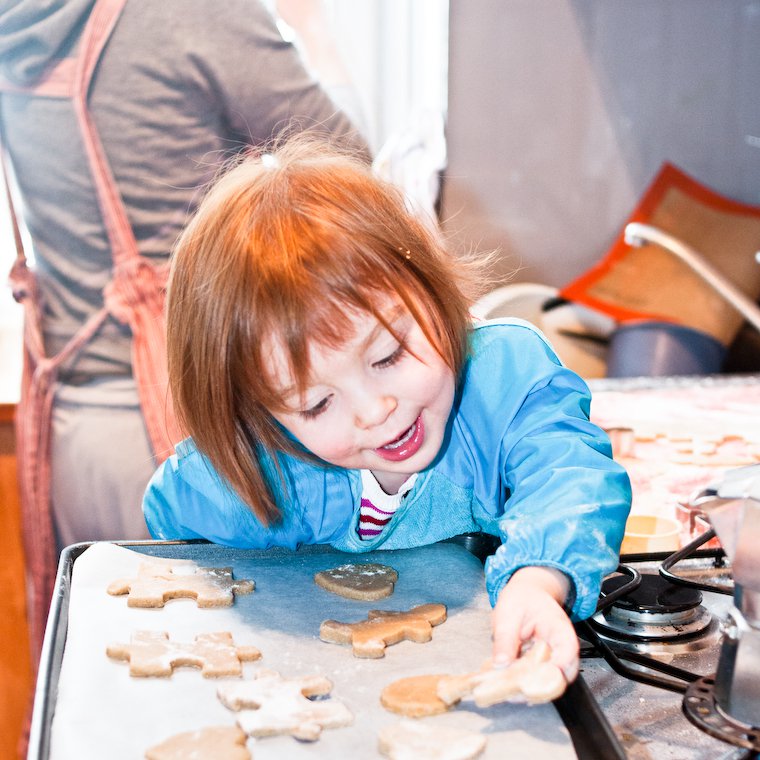
Olivia making cinnamon cookies
Over time, have you developed staple dishes or strategies that make it possible to prepare a meal and keep the kid happy at the same time?
We try to prepare Olivia’s food in advance; it started when she was a baby. On Sunday, we’d go to the greenmarket and use our fresh produce to concoct industrial quantities of apple sauce or other fruit compotes, puréed carrots, potatoes, zucchini, etc. Just like another parent featured in this column, Tamami Haga, we also freeze everything flat in zip-lock bags. We have a small freezer so it helps to save space. (Be sure to label and date everything!)
As Olivia has moved beyond purées, we’ve continued to prepare food for her in advance and freeze it. It’s amazing how many things freeze really well. She loves Clotilde’s roasted cauliflower minus the fish sauce; I just made a batch for her last night. Now that she’s older, we also try to make extra of what we have for dinner and she’ll eat it the next night. For her starch we have a wide variety of pasta, rice, and grains on hand. I also cook, purée and freeze potatoes and sweet potatoes. I add vegetables to everything, for example: mashed potatoes AND zucchini, mashed sweet potato AND Hokkaido squash, omelet with spinach or Swiss chard, etc.
Olivia was in her baby seat in the kitchen with us at a pretty young age, so she’s used to it. As she got older she would play with toys or draw while we cooked. I kept special toys in the kitchen just for the high chair. Now, she eats while we cook our meal and she helps cook her own.
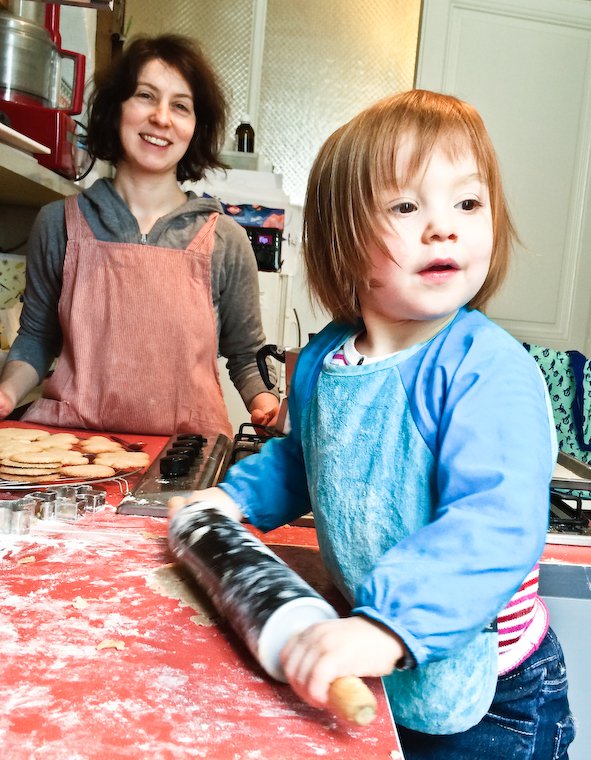
Olivia rolling out the dough for cinnamon cookies
Have you found ways to involve your daughter in the cooking process?
Olivia began cooking with us just before she turned two. I started by having her make cookies with me on a Saturday morning when we didn’t have any time constraints. She helped me measure: scooping ingredients, pressing the buttons on the scale. Then she pressed the buttons on the food processor. She loves watching it go! Then cutting the cookies into shapes, placing them on the tray. At some point I “sacrificed” some dough and let her play with it. When our product was complete she gave an enthusiastic “Woooow!” and was delighted to taste!
Now we try to give her any task she can manage. Putting salt in the pot before we pour in the boiling water for pasta or a grain. Deveining spinach is a great sorting game; washing it is a lot of fun! She takes the frozen food out of bags and discovers the cold and wet feeling. She helps cut butter to put on her quinoa, bulgur, or other grain. We’re teaching her to pour carefully, stir, beat, and even cut. She enjoys brushing olive oil and vegetables to grill. Bruno has her put her hand on his when he cuts soft things like avocado or beet, and she knows to “puuuush”, she truly guides the movement. When I cut she says, “Watch your fingers, Mommy!” She takes things out of the fridge and puts them away upon request.
I think it works for us because she has come to understand that the kitchen is an important place for our family. We’ve taught her that cooking is a privilege and she knows that if she doesn’t follow instructions she loses the privilege. She has been very upset when that has happened, so it happens rarely.
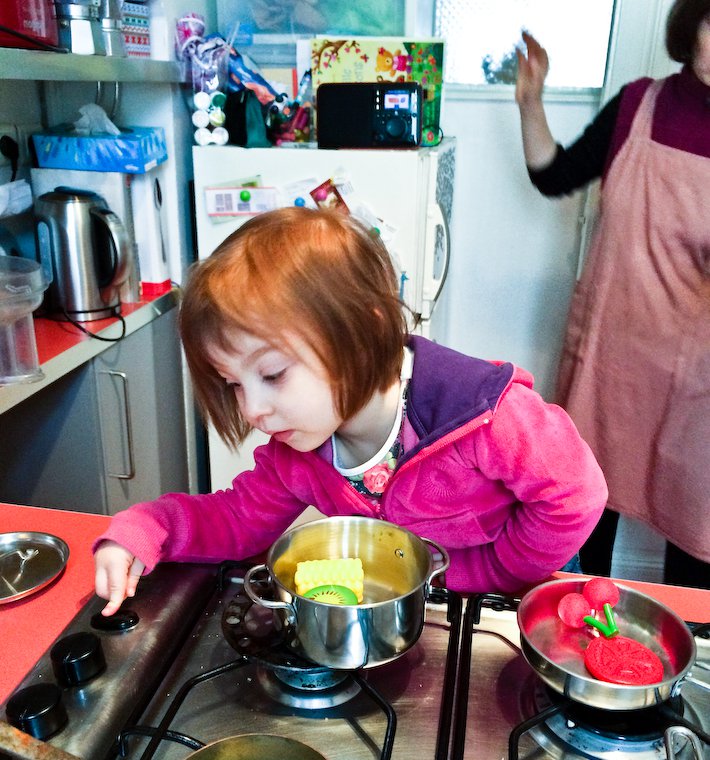
Olivia manning the gas stove (!)
As someone who’s passionate about food, can you talk about the joys and challenges of feeding your child, and how you go about teaching her to be a happy, adventurous eater?
We were so incredibly excited for Olivia to try solid food, we thought she would open her mouth, taste, swallow and ask for more. We were sorely disappointed. Puréed carrots were at first some bizarre form of torture. This initial experience was indicative of the ups and downs of the whole process of teaching a child about food. As young children try foods for the first time, it’s important to stay calm and not feel offended when your child rejects the dish you just spent hours preparing. Freeze the leftovers and then try and try again! I can’t remember where I heard or read a pediatrician say a child has to try a food thirty times before determining that he or she really and truly does not like it!
Olivia is resistant to trying new things. We ask her to taste one bite, sometimes she does, sometimes she doesn’t, and then we don’t make her finish it if she doesn’t want to. We do know, however, that even though she resists trying, she usually ends up eating the thing and liking it.
We tend to be more strict at home about having her eat all or most of her meal before moving on to yogurt or fruit. When we’re out at restaurants or with friends, we offer her a bit of everything and don’t make a big deal if she doesn’t eat a well-rounded meal. Learning to choose your battles is another key to parenting in general, and to happy meals.
Like so many things children learn by example. We see mealtime as a fun, relaxing and pleasant time to eat delicious foods, try new foods and be together as a family. We feed her things we eat ourselves and always encourage her to taste. She wants to do what we do, she wants to eat what we eat. We even feed her things we don’t like — beets and sheep’s milk yogurt for example — and she loves them. Maybe we have to try them thirty times too!
